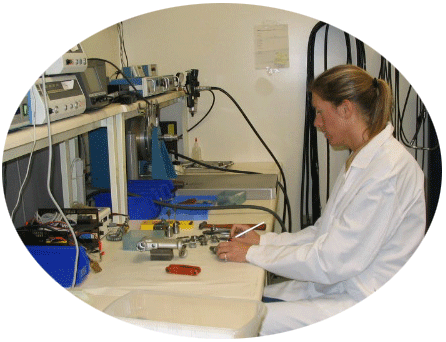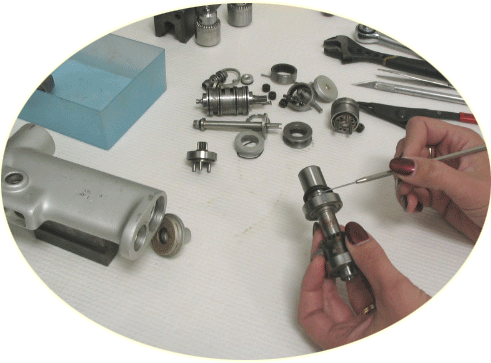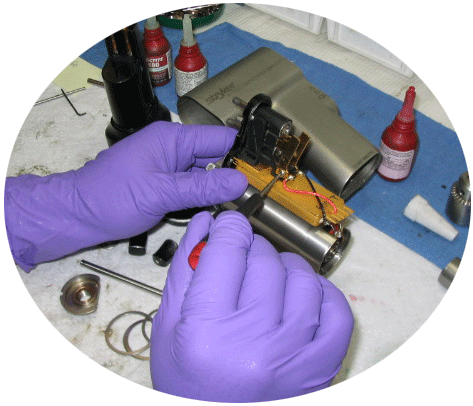Powered instruments are precision instruments that require special handling by trained personnel. Strict adherence to maintenance procedures recommended by the manufacturer can prevent premature failure. In addition to manufacturer recommendations, we have included a few supplementary guidelines..
NOTE: This is only a supplement to the manufacturer's recommended maintenance guidelines.
Preoperative:
• Inspect handpieces and attachments for damage, corrosion, and fluid
Inspect handpieces and attachments for damage, corrosion, and fluid
• Inspect air hoses or cables for leaks and damage
Inspect air hoses or cables for leaks and damage
• Inspect all safety mechanisms, do not use if instrument runs while safety mode is on.
Inspect all safety mechanisms, do not use if instrument runs while safety mode is on.
• Test run the instrument with attachment for 30 sec., do not use if excessive noise and/or heat is detected
Test run the instrument with attachment for 30 sec., do not use if excessive noise and/or heat is detected
Do not use instrument if any damage is detected!
Intraoperative:
• Place instrument on a dry open tray, avoid crowding with other instrument
Place instrument on a dry open tray, avoid crowding with other instrument
• Do not use excessive force while cutting or drilling, excessive force will damage gears and motor
Do not use excessive force while cutting or drilling, excessive force will damage gears and motor
• Minimize exposure to fluids, fluids such as saline will accelerate the oxidation process, causing corrosion.
Minimize exposure to fluids, fluids such as saline will accelerate the oxidation process, causing corrosion.
• Make sure safe mode is ON while not in use
Make sure safe mode is ON while not in use
• Avoid using reprocessed blades and burs, damaged blades and burs, usually undetectable, causes damage to gears and motor
Avoid using reprocessed blades and burs, damaged blades and burs, usually undetectable, causes damage to gears and motor
• Monitor temperature at collet ( luke warm is OK)
Monitor temperature at collet ( luke warm is OK)
Postoperative:
A. Immediately Following Procedure
• The handpiece should be in a horizontal position during transport to prevent fluids from entering
The handpiece should be in a horizontal position during transport to prevent fluids from entering
• Avoid crowding with other instruments
Avoid crowding with other instruments
• To avoid contamination, place a towel moistened with enzymatic cleaner over the instrument
To avoid contamination, place a towel moistened with enzymatic cleaner over the instrument
• Wipe down the handpiece and air hose with enzymatic detergent
Wipe down the handpiece and air hose with enzymatic detergent
• Remove all attachments and bur, but not the hose or cable. The hose and cable, while attached, acts as a seal preventing fluid from entering the handpiece
Remove all attachments and bur, but not the hose or cable. The hose and cable, while attached, acts as a seal preventing fluid from entering the handpiece
B. Rinsing
• Rinse the handpiece with warm running water while pointing the collet downward to prevent fluid from entering. Distilled water is recommended, rinse briefly
Rinse the handpiece with warm running water while pointing the collet downward to prevent fluid from entering. Distilled water is recommended, rinse briefly
• For electrical handpiece: wipe thoroughly with enzymatic detergent until all contaminants are removed.
For electrical handpiece: wipe thoroughly with enzymatic detergent until all contaminants are removed.
• Rinsing should remove all blood, fluids, and tissue
Rinsing should remove all blood, fluids, and tissue
• NEVER IMMERSE THE HANDPIECE IN ANY TYPE OF FLUID
NEVER IMMERSE THE HANDPIECE IN ANY TYPE OF FLUID
o An immersed instrument will most likely be damaged, however, the following steps can sometimes restore the instrument to working order.
C. Disinfecting
• Use a mild enzymatic cleaner (neutral pH) with warm water and a sponge or towel to remove the remaining contaminants
Use a mild enzymatic cleaner (neutral pH) with warm water and a sponge or towel to remove the remaining contaminants
• Do not use any acidic cleaner such as bleach, 409, ammonia, etc...Acidic cleaners cause corrosion and severe pitting
Do not use any acidic cleaner such as bleach, 409, ammonia, etc...Acidic cleaners cause corrosion and severe pitting
• Rinse the handpiece briefly under warm running water (collet facing downward with the hose still attached)
Rinse the handpiece briefly under warm running water (collet facing downward with the hose still attached)
• NEVER EXPOSE THE HANDPIECE TO BLEACH OR OTHER CORROSIVE CHEMICALS. EXPOSURE WILL CAUSE SEVERE PITTING AND WILL VOID ALL WARRANTIES
NEVER EXPOSE THE HANDPIECE TO BLEACH OR OTHER CORROSIVE CHEMICALS. EXPOSURE WILL CAUSE SEVERE PITTING AND WILL VOID ALL WARRANTIES
• Always use proper sterile techniques in handling instruments
Always use proper sterile techniques in handling instruments
D. Sterilization
• Prior to autoclaving, check functionality of the handpiece.
Prior to autoclaving, check functionality of the handpiece.
• Check for air leaks from hose and handpiece
Check for air leaks from hose and handpiece
• Make sure the bur locks in properly, if you can pull the bur out with your hand while it is in the locked position, the handpiece needs service.
Make sure the bur locks in properly, if you can pull the bur out with your hand while it is in the locked position, the handpiece needs service.
• Run the handpiece for 30 seconds. If an inconsistent sound frequency and heat are detected, the handpiece needs service.
Run the handpiece for 30 seconds. If an inconsistent sound frequency and heat are detected, the handpiece needs service.
• Lubricate instrument according to manufacturer's guideline. Do not lubricate instruments that do not require lubrication, otherwise damage to the motor and bearing will occur.
Lubricate instrument according to manufacturer's guideline. Do not lubricate instruments that do not require lubrication, otherwise damage to the motor and bearing will occur.
• Autoclave the instrument according to the manufacturers’ guideline
Autoclave the instrument according to the manufacturers’ guideline
• Make sure the dry cycle has been completed to ensure the complete removal of internal moisture. Any moisture left internally will lead to corrosion and pitting
Make sure the dry cycle has been completed to ensure the complete removal of internal moisture. Any moisture left internally will lead to corrosion and pitting
• Allow the instrument to cool down at room temperature. Forced cooling will trap moisture inside the handpiece
Allow the instrument to cool down at room temperature. Forced cooling will trap moisture inside the handpiece




